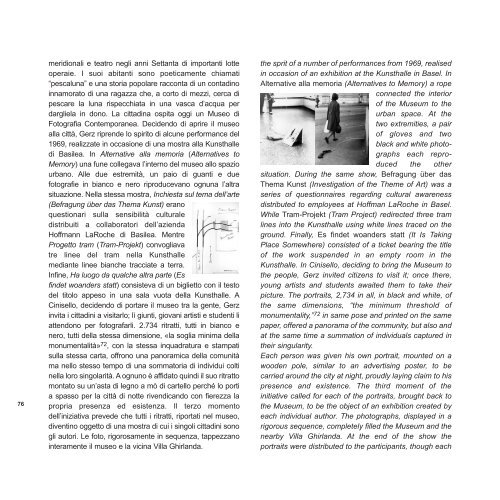Adachiara Zevi - arteinmemoria
Adachiara Zevi - arteinmemoria
Adachiara Zevi - arteinmemoria
Create successful ePaper yourself
Turn your PDF publications into a flip-book with our unique Google optimized e-Paper software.
76<br />
meridionali e teatro negli anni Settanta di importanti lotte<br />
operaie. I suoi abitanti sono poeticamente chiamati<br />
“pescaluna” e una storia popolare racconta di un contadino<br />
innamorato di una ragazza che, a corto di mezzi, cerca di<br />
pescare la luna rispecchiata in una vasca d’acqua per<br />
dargliela in dono. La cittadina ospita oggi un Museo di<br />
Fotografia Contemporanea. Decidendo di aprire il museo<br />
alla città, Gerz riprende lo spirito di alcune performance del<br />
1969, realizzate in occasione di una mostra alla Kunsthalle<br />
di Basilea. In Alternative alla memoria (Alternatives to<br />
Memory) una fune collegava l’interno del museo allo spazio<br />
urbano. Alle due estremità, un paio di guanti e due<br />
fotografie in bianco e nero riproducevano ognuna l’altra<br />
situazione. Nella stessa mostra, Inchiesta sul tema dell’arte<br />
(Befragung über das Thema Kunst) erano<br />
questionari sulla sensibilità culturale<br />
distribuiti a collaboratori dell’azienda<br />
Hoffmann LaRoche di Basilea. Mentre<br />
Progetto tram (Tram-Projekt) convogliava<br />
tre linee del tram nella Kunsthalle<br />
mediante linee bianche tracciate a terra.<br />
Infine, Ha luogo da qualche altra parte (Es<br />
findet woanders statt) consisteva di un biglietto con il testo<br />
del titolo appeso in una sala vuota della Kunsthalle. A<br />
Cinisello, decidendo di portare il museo tra la gente, Gerz<br />
invita i cittadini a visitarlo; lì giunti, giovani artisti e studenti li<br />
attendono per fotografarli. 2.734 ritratti, tutti in bianco e<br />
nero, tutti della stessa dimensione, «la soglia minima della<br />
monumentalità» 72 , con la stessa inquadratura e stampati<br />
sulla stessa carta, offrono una panoramica della comunità<br />
ma nello stesso tempo di una sommatoria di individui colti<br />
nella loro singolarità. A ognuno è affidato quindi il suo ritratto<br />
montato su un’asta di legno a mò di cartello perché lo porti<br />
a spasso per la città di notte rivendicando con fierezza la<br />
propria presenza ed esistenza. Il terzo momento<br />
dell’iniziativa prevede che tutti i ritratti, riportati nel museo,<br />
diventino oggetto di una mostra di cui i singoli cittadini sono<br />
gli autori. Le foto, rigorosamente in sequenza, tappezzano<br />
interamente il museo e la vicina Villa Ghirlanda.<br />
the sprit of a number of performances from 1969, realised<br />
in occasion of an exhibition at the Kunsthalle in Basel. In<br />
Alternative alla memoria (Alternatives to Memory) a rope<br />
connected the interior<br />
of the Museum to the<br />
urban space. At the<br />
two extremities, a pair<br />
of gloves and two<br />
black and white photographs<br />
each reproduced<br />
the other<br />
situation. During the same show, Befragung über das<br />
Thema Kunst (Investigation of the Theme of Art) was a<br />
series of questionnaires regarding cultural awareness<br />
distributed to employees at Hoffman LaRoche in Basel.<br />
While Tram-Projekt (Tram Project) redirected three tram<br />
lines into the Kunsthalle using white lines traced on the<br />
ground. Finally, Es findet woanders statt (It Is Taking<br />
Place Somewhere) consisted of a ticket bearing the title<br />
of the work suspended in an empty room in the<br />
Kunsthalle. In Cinisello, deciding to bring the Museum to<br />
the people, Gerz invited citizens to visit it; once there,<br />
young artists and students awaited them to take their<br />
picture. The portraits, 2,734 in all, in black and white, of<br />
the same dimensions, “the minimum threshold of<br />
monumentality,” 72 in same pose and printed on the same<br />
paper, offered a panorama of the community, but also and<br />
at the same time a summation of individuals captured in<br />
their singularity.<br />
Each person was given his own portrait, mounted on a<br />
wooden pole, similar to an advertising poster, to be<br />
carried around the city at night, proudly laying claim to his<br />
presence and existence. The third moment of the<br />
initiative called for each of the portraits, brought back to<br />
the Museum, to be the object of an exhibition created by<br />
each individual author. The photographs, displayed in a<br />
rigorous sequence, completely filled the Museum and the<br />
nearby Villa Ghirlanda. At the end of the show the<br />
portraits were distributed to the participants, though each


